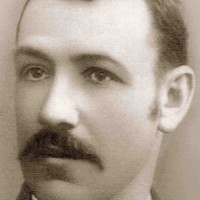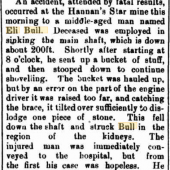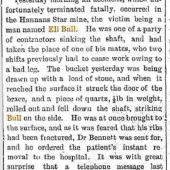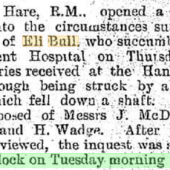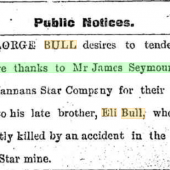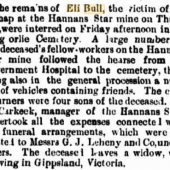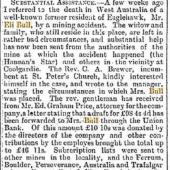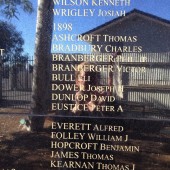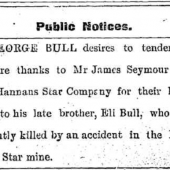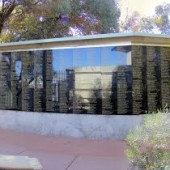Eli BULL
Age at Death40
Date Of Death17 March 1898 : Reg 455/1898
Place Of BirthCastlemaine, Victoria
OccupationMiner
Spouse's NameMargaret Jane PLUNKETT (1859-1942)
ChildrenEli, born 1880 - Robert Alexander born 1882 - Samuel Joseph born 1883 - Margaret Jane born 1886 - Edward Eli born 1888 - Robert Alexander born 1891 - Hilda Maud born 1893 - Daisy May born 1895.
Name Of Mine On Which Last Employed
Hannans Star GM, Kalgoorlie-Boulder, Western Australia
Diagnosis or cause of accident
Bull, while baling out a shaft about 195ft. below the surface, was struck by a piece of quartz weighing ~½lb which had fallen out of kibble as it reached the surface.
Place Of Burial
Kalgoorlie Cemetery, Western Australia
Submitted by
Ian Hodkinson - Volunteer
MSW
Married
District
Kalgoorlie-Boulder
Cause of Death
Mine Accidents
Father
Samuel George BULL (1831-1918)
Mother
Esther Jane DUNSDON (1835-1871)
Place of marriage
1879 - Eaglehawk, Victoria
Other Information
There is a street named after him in Somerville, Kalgoorlie - Bull Way.
Family was in Bendigo, Victoria.
Evening Star, Tuesday 22 March 1898, page 3
The Hannans Star Fatality - INQUEST ON ELI BULL
At the Kalgoorlie Court this morning the inquest on the body of Eli Bull, who was killed in the Hannans Star mine, near Boulder City, was continued before Warden Hare and a jury of three, consisting of Jas. McDonald, Henry Wadge, and William Complin. Mr F. J Lauder, Inspector of Mines, was in attendance. John Bond said he was employed in the Hannans Star mine on the 17th inst The deceased was working with him in a level, about 195ft. below the surface. The deceased was bailing water. Witness's other mate, Reynolds, was just standing on the plat. He and the deceased had sent away a bucket of dirt. This was about 10 minutes to eight. The bucket was nearly full. Shortly afterwards he heard a whizzing sound and his mate, Bull, fell. He picked him up and communicated with the others in the plat. Reynolds spoke and witness said "I believe my mate is killed." Witness picked deceased up and put him in the bucket and rode to the surface with him. He did not see the stone which struck him. Deceased was conscious when he was taken to the surface.
Dr. Bennett was present and attended to his injuries, and witness assisted to take him to the Government hospital. Could not account for the stone falling. If everything was working properly it was impossible for a stone to fall out. To the Coroner : Reynolds assisted witness to put the deceased in the bucket. There was sufficient time for the bucket to get to the surface before the stone fell. When a bucket went up it ascended straight to the surface. Witness always made it a practice not to fill the bucket too full. Archibald Love, resident surgeon at the hospital, remembered the deceased being admitted into the hospital. He died the same day. He had a wound on the left side of the region of the kidney. Later in the day he found the injured man had a rupture of the left kidney. He died the same evening about 7 o'clock. The cause of death was due to shock and haemorrhage resulting from the rupture.
To Corporal Nicol : A small stone falling that distance would have caused the injury. Samuel Reynolds corroborated Bond's evidence. He was 50ft. above the deceased when he was killed. He noticed a fairly filled bucket of mullock going up. He heard Bond calling to him but did not know anything was wrong. When the bucket passed him he thought all was right. He believed both Bull and Bond were practical and careful men. Did not know if water or stone was signalled by the men on sending the bucket up. William H. Holmes, braceman, said before the bucket came up he got a signal of three rings which meant both water and stone. There was one door at the mouth of the shaft, to land bucket on. It worked on a hinge. The half door was self acting, It was down when he got the signal for the bucket. He did not open it, nor did he make any effort to do so prior to the stone falling. It was his duty to open the door. If he was not there, the bucket would be hung up in the shaft, which would cant the bucket. The engine-driver could see the bucket as it came to the surface. He was about 40 feet from the shaft. He opened the door for the bucket to pass through. If it were mullock, he closed the door as soon as it had gone through. He had to land all material brought up the shaft. He saw the bucket strike the door, and could see the bucket cant. He was hurrying up the brace at the time to open the door at the time when he saw it. The engine-driver stopped the bucket as soon as he saw it strike the door. Witness, saw the stone fall. He couldn't say how large the stone was. The bucket was filled as usual to about six inches from the top. When he got to the brace door the bucket was hanging on the perpendicular, just touching the door. There was just room for it to swing off. To the Foreman : When he got signals he didn't know if the bucket held water or stone. Had he been at the brace he didn't think the accident would have happened. The reason why he was not there was because he had sent down for water, and thought it was being sent up. There were no lifts on the door, which had to be opened by hand.
To the Coronor : The water always landed at the surface, and for that reason he was not on the brace. The men sent up water or stone just as required. He never knew distinctly what was coming up. When the bucket struck he was half way up the steps. He had to land both the water and the stone. John Sheilds, certificated engine-driver at the Hannans Star mine, was hauling mullock on the morning in question. When it reached the top the edge caught the side of the door. It was going very slowly. He saw it cant slightly, and stopped it at once. There was no distinction in the signals for water and mullock— three knocks each. It had been altered since. He could tell on the engine the difference between the weight of mullock and water. It was his duty to stop the bucket as soon as it got to the top. To the Foreman : He received no instructions from the manager not to haul a bucket to the surface in case the braceman was not there. He didn't know where the braceman was at the time. He generally stopped so as to allow the braceman to take the bucket off. He saw a stone falling, and it appeared to go straight down the centre of the shaft. To the Coroner : Every mine had his own code of signals. It was not the usual thing for bracemen to attend to both the stone and water, but they had done it in this case. Martin Carkeek, manager of the Hannans Star mine, explained that the bracemen were employed by the con-tractors who were sinking the shaft. The braceman was responsible for the landing of the buckets and for opening and closing the doors.

